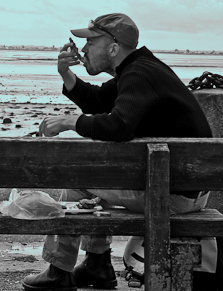Joe Ray
Food & Travel / Words & Photos
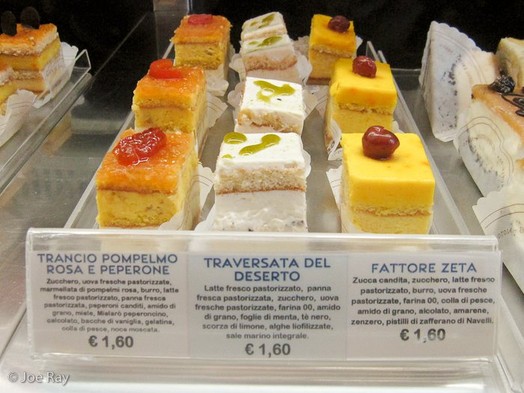
Friday, May 15, 2009
Let Mom Eat Cake
NOTO, SICILY
I’m back in The Motherland.
It’s a work/play trip that includes bringing my parents to the land of our Sicilian ancestors for the first time. My sister and I are English, Irish, French, Italian, Dutch and German mutts, but it’s always been the Sicilian side – via our paternal grandmother – that we identify with most as a family.
I’m playing tour guide so the induction is based on food and Day One includes a visit to pastry chef Corrado Assenza’s appropriately named Caffè Sicilia.
While Assenza’s ideas and creations can be otherworldly, he’s a product-sourcing freak. If he can’t do it perfectly, he won’t do it.
His almond gelato not only tastes like an almond in another state, but even has the slight tannic tang from the almond skin along with a mix of minerals and salt in the skin that makes Sicilian almonds unique.
We also try a “Traversata del Deserto†– a cake that includes mint, black tea, lemon rind, sea salt and “lyophilized†(freeze-dried) algae. It’s the kind of thing that Mom would try but stop after one bite.
Instead, she makes a funny grunting noise, almost like she’s disappointed.
“I’m sorry for all the cakes that will come after this in my life.â€
Caffè Sicilia MAP
Corso Vittorio Emanuele, 125
Noto, Sicily
Full disclosure: Assenza, who I’ve interviewed and written about in the past, came out to say hello while we were there, but we paid our bill and you can’t bake a cake or make gelato on the fly.
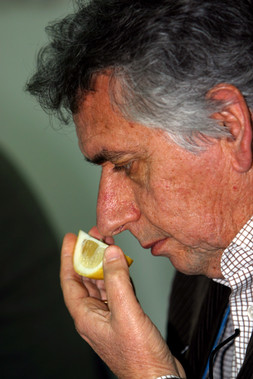
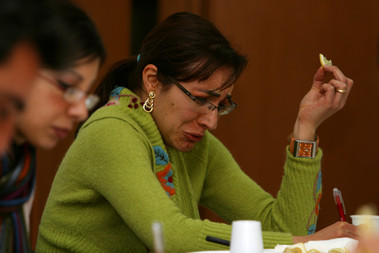
Friday, February 16, 2007
Sucking Lemons with the Pros
Here in southern Sicily, lemon and orange groves seem to line every road, but the idea of a lemon tasting I was invited to sounded rather masochistic. It made me think of a puckered-up version of that old National Geographic picture with the line of women in lab coats sniffing men’s underarms.
Plus, a lemon’s a lemon, right?
Not so, thinks Dr. Giuseppe Cicero who works for Italy as a sensorial analyst and food-quality controller.
Cicero’s lemon tasting directly followed a tasting of renowned Modican chocolate and the two couldn’t have elicited more different reactions. He wheeled several hospital carts’ worth of lemons on numbered plastic plates out to his tasters. These local food professionals taste with Cicero weekly. They clearly enjoyed the chocolate, but their bodies were definitely at odds with the idea of straight lemon.
Far from the physical restraint normally seen at wine tastings, here the tasters recoiled, puckered, shuddered, occasionally giggled, and generally tended to look like they were having way less fun than they did with the chocolate.
Clearly, they were pushing themselves toward their task for the good of humanity. But what good?
“We’re looking for both common characteristics and what differentiates them,” said Cicero. “Tomatoes and carrots come from the earth and they speak of the earth. They have a primal link to their territory. We want to transfer these sensations to the people who eat them.”
In wine terms, he sounded like a sommelier who was trying to make a bottle sound better than it was, so I asked for my own plates of lemons.
Like his tasters, I had trouble pulling a plate full of lemons toward me, but then a funny thing happened.
On a good day, when I poke my nose in a glass of wine, I can pick out a few key elements; something really good will actually give me goose bumps or a flicker of emotion.
Here, the smell of lemons, of all things, triggered memories and feelings, and each type of lemon brought something different.
I tasted them, and puckered and shuddered like everyone else in the room, but, without really thinking about it, how each lemon should be used in cooking came to me, no question - clear as day. One was for vinaigrette, another, with a deeper flavor, for broiled scallops, the third was made to go in seltzer water or to flavor desserts, and number four was made for…squid.
If only wine pairings came to me this easily.
I tell Cicero all this and he blames man.
“Winemaking has a huge amount of human intervention and these [lemons and other fruits and vegetables] have none. It’s a direct link to the elements of the tree and around it.”
“We’re trying to get people to think of the importance of what they put in their mouths,” he said. “We want them to say, ‘This comes from my land.’”
Speak of the earth, indeed
This is Joe Ray reporting from the Motherland.
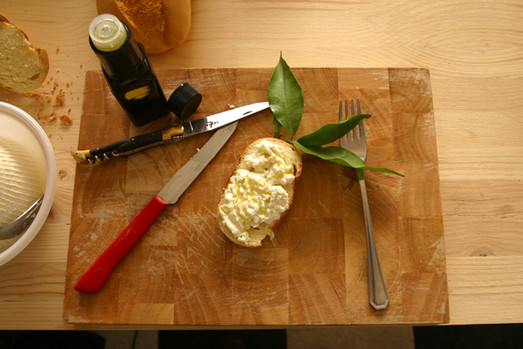
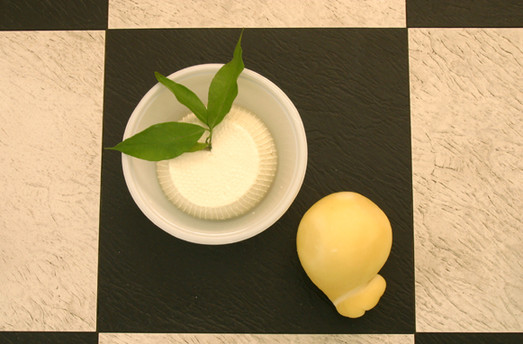
Wednesday, February 14, 2007
Ricotta a la Truck
The concept of “dining a la truck” in Sicily was introduced to me over a loudspeaker. I was still in bed.
Amplified, garbled voices came through the window. I’d only been on the island for about 10 hours and was sure it was local politicians trying to convince the local populace to vote for them. Mercifully, they disappeared and I went back to sleep.
Later, I took a break from work and scanned the rotary from the office window. Below, a woman gave money to a man next to a small white car then walked away, gently cradling a wheel of ricotta.
I ran.
Giuseppe Cappello is a third-generation cheesemaker and seller on wheels.
He opened the back of his tiny white car, then scooped a wheel of ricotta out of a large, white tub containing several other wheels floating in whey.
“When people buy it, the cheese is between half an hour and an hour old,” said Cappello, who sells to an estimated 120 clients and one restaurant from his car. He and his wife Enza also sell to wholesale clients from their farm on the edge of town.
“We’re proud to say that our ricotta is sold hot,” he added, seemingly unaware that he’s got most pizza chains’ claims to fame beat coming and going.
The cheese was still warm.
I paid and ran again, this time toward my kitchen with neighbors shouting quick suggestions on what to do with my prize; one woman ate hers with salad and the quick-e-mart guy said he folded it into his kid’s pasta.
The ricotta had a custard-y texture similar to the white of a soft-boiled egg; a snow-white miracle in a tiny, plastic colander. I cut some bread, added some still-warm ricotta, poured some local olive oil and a sprinkle of salt over it, took a bite and, well, groaned with pleasure.
Tomorrow, I head out in a three-wheeled Vespa truck with the baker…
This is Joe Ray reporting from the Motherland.
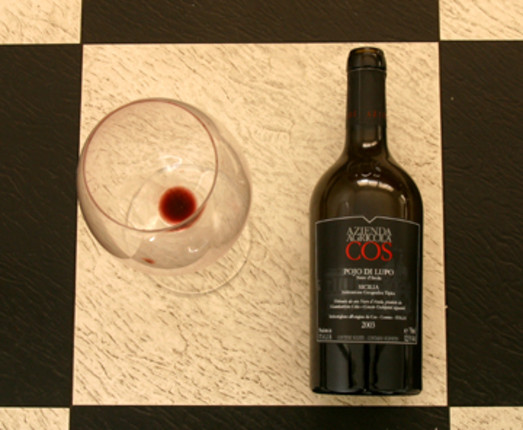
Wednesday, February 07, 2007
Rock & Avola in The Motherland
We have been threatening to seriously taste some wines together since I got here. Tonight, we made good on the promise and I got a sort of Sicilian wine primer as a bonus.
I grabbed the wine from its display space next to its empty cousins on my kitchen floor and stole some big, beautiful tasting glasses from an undisclosed location. To keep the babes of Ispica at bay, we tasted in the office.
I put on some Green Day and Visqueen and we dove in.
The wine was a 2003 “Pojo di Lupo” – made entirely of one of Sicily’s best known grapes, the Nero d’Avola (Black from Avola), from the COS vineyard in the nearby town of Comiso.
We discuss the color – I say “ruby with a brown edge,” and F. says “pomegranate.”
“Is that ‘grenade?’” (like the French), I ask.
“Do you mean in Italian or Sicilan?” he replies.
“Either.”
“No.”
“Nero d’Avola is a grape that’s historically important to Sicily and in the last few years, has become trendy [in other parts of Sicily],” he explained. This latter part raises the hackles of the people in this neck of the woods, as they’d like to see it come from somewhere closer to Avola. Typically, this means towns within a tight radius – Ispica, at about 15 miles from Avola makes the cut, but Comiso, at 30, starts raising eyebrows.
Then again, Avola is the town with an Eiffel Tower replica next to a lit up jet fighter at a bend in the road.
The grape’s newfound popularity is a double-edged sword: Sicily finally gets some well-deserved recognition for making a great wine, but it also means that the number of morons out there making bad wine with good grapes increases.
The nose is where things got interesting.
In a tasting, I can usually tell when I’ve left France, but here things were very different.
“When you go from France to Sicily, it’s like going to Mars,” said F.
This certainly felt like an alien landscape, but a half hour of swirling and smelling before we took a sip began to bear fruit: for me, this wine had a smell of marinated cherries, then something that seemed to me to be mint or menthol that F. pegged as a woody balsamic smell. The last smell was the hardest to peg – somewhere between tea (it reminded me of mom’s Red Rose) and tobacco, the latter turning out to be one of the typical undertones in a Nero d’Avola. Woohoo! For someone like me who gets excited when I can pick one key element out of a wine when I’m really trying, getting three was exciting in a food geek kind of way.
In the mouth it tasted exactly like it smelled – how’s that for well-balanced?
This isn’t always the case, and it turned out to be one of the peculiarities of this producer’s version of the wine, for better and for worse. Nero d’Avola tends to be huge, and the producers reigned it in so much that the tobacco stood out and the big berry tastes that are its hallmarks didn’t even show up until we had the bottle open for a couple of hours.
That said, we finished the bottle; with wine that tends to be huge and full of alcohol (products of the Sicilian sun), you’re either ready to go to bed or chase Sicilian women after a glass or two.
At the end of the night, we switched music to some of F’s favorites - Gerry Mulligan, Steely Dan, and David Bowie doing a curious Beatles cover. Then Frank Sinatra came on and F. grinned, smiled, whistled and tapped his feet.
Which is exactly what should happen when you’re enjoying what you drink.
This is Joe Ray reporting from the motherland.
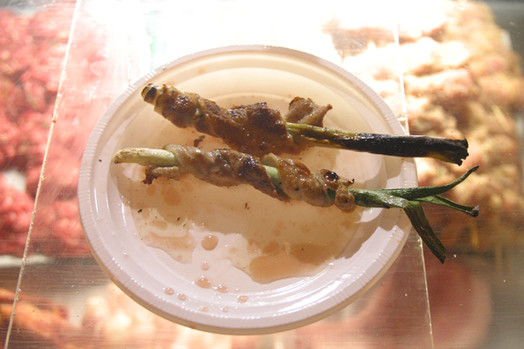
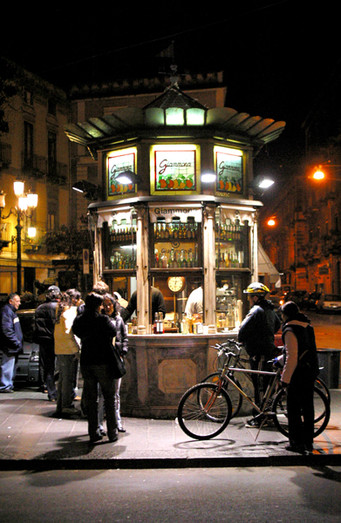
Friday, February 02, 2007
Street Food, Sicilian Style
Walking through the town of Catania, Francesco explained its Festa di Sant’Agata as best he could.
“Agata (like Agatha, with a better sounding name) was the daughter of a noble family, destined to be married to a guy from another family. But she preferred to die because she was devoted to God,” he said, sounding reasonably certain.
“But it’s impossible to starve in this town,” he said.
After working a full day in Ispica yesterday, we hopped in the car and set off on the hour-and-a-half trek to Catania to prepare ourselves for the Feast of Saint Agata.
“Catania is one of the most important places in Italy for street food,” Francesco mentioned a day earlier.
I’m not sure what he was thinking about for the first two days I was here.
We started off with a couple of false trails, which only served to heighten our hunger, before finding a place with a blue neon star with a red letter “A” in the center. Inside, immediately on the left at hip-level, were three vats big enough to fry a horse head or small kid in, with nothing to keep customers from falling in; I’d say “Darwin would love it here,” but my sister would point out that I almost fell into a Frialator once.
A big woman behind the counter introduced us to crispelle, fritter-like things of two different flavors and sizes. We had a ball-shaped one stuffed with ricotta and another, more mangled-stick shaped with anchovies in the middle. I could taste the genius potential, but they were leftovers at the end of the night, and she gave them to us, promising that she’ll set up a full testing plate for us when we go back this weekend. Yeehaw!
Afterward, we wheedled our way through the creepy/beautiful Santo Spirito neighborhood on our way to another street food hotspot. It seemed to be one of those places where you walk in the street because you’re worried you might fall into a hole in the sidewalk.
“I see smoke,” I said.
“That’s our place,” replied Francesco.
Frankly, coming out of Santo Spirito (which Francesco assures me is about to become the town’s next hotspot), the people crowding around the source of the smoke looked like bums around a trash can in the movies. Then we got closer and I could smell how wrong I was.
Via Plebiscito is aptly named, as it’s the where Catania’s street food freaks, err, vote to eat on their feet.
Lining the street, nearly every butcher shop and restaurant has a big, square grill flaming away in front of it and stout men impervious to heat use stubby tongs or their blackened, bare hands flip sausages, large spring onions wrapped in bacon, pork products, breaded quail and, my recent favorite, and the neighborhood specialty, horse steak sandwiches. On the grill, most of the products are regularly brushed with a sort of oregano vinaigrette. The grill tenders, one of whom was carrying an obscene stack of cash in his apron pocket from the night’s haul, flick salt onto the meat in a sort of long-distance sidearm Rollie Fingers style.
Say what you will about eating Trigger, but piled on a big bun and sloshed with the vinaigrette, horse is good stuff. Among other selections, the star of the street was the spring onions wrapped in unsmoked bacon. Sweet, simple, vinegar-y goodness.
Stuffed, we went to Francesco’s favorite places for those tamarind syrup with lemon and sodium bicarbonate drinks to help digest it all – at a little street stand called Giammona. Apparently, Francesco wanted to make sure he trusted me a little more before showing me the best in the city.
He was right and I’m hooked. Fuzzy goodness in a cup.
“It’s a ritual,” said Francesco, “I can’t leave town without stopping there. For me it’s like shutters going down at the end of a meal. After that, I close.”
Technically, we didn’t close – we went and got cannolis at a 24-hour place, and those aren’t technically street food. But they are a story for another day…
This is Joe Ray reporting from the Motherland.
